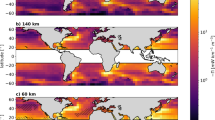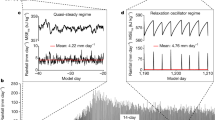Abstract
THE Earth–atmosphere is a classic example of a closed, dissipative and nonlinear thermodynamic system which is subject to both regular and irregular impulses causing significant departure from steady state. It is closed because it exchanges energy (solar and thermal radiant energy) but not mass with its environment. It is dissipative because the net input of radiant energy occurs mainly in regions of high temperature towards the Equator and the net output occurs mainly in regions of low temperature towards the poles. It is nonlinear basically because of the multiplicity of internal feedbacks and because of the importance of advective processes. It has steady-state character in the sense that the annual mean radiant energy input is very close to the annual mean output, and parameters such as the annual mean temperature do not vary significantly from one period to another. The regular seasonal variation in solar position ensures significant departure from the steady state so defined, and there are also significant irregular departures arising (for instance) from variations of solar input and IR output caused by variations in the amount and distribution of cloud. Recently I have shown1 that the overall Earth–atmosphere climate system seems to have adopted a format whereby the total thermodynamic dissipation associated with the horizontal energy flows in the atmosphere and ocean is a maximum. ‘Format’ in this context refers to the annual average geographic distribution of cloud, surface temperature and the horizontal energy flows. The practical significance of this is that, if one could accept it as a general principle governing climate behaviour, one could use it directly as a means of a priori prediction of climate and climate change without needing detailed analysis of the internal workings of the system. I could not explain previously why the Earth–atmosphere system should be so constrained. This note points out that the Earth–atmosphere has characteristics such that it might be expected to obey such a constraint. Furthermore, these characteristics are sufficiently general that the same principle of selection of steady-state mode of maximum dissipation may apply to a broad class of non-linear systems.
This is a preview of subscription content, access via your institution
Access options
Subscribe to this journal
Receive 51 print issues and online access
$199.00 per year
only $3.90 per issue
Buy this article
- Purchase on Springer Link
- Instant access to full article PDF
Prices may be subject to local taxes which are calculated during checkout
Similar content being viewed by others
References
Paltridge, G. W. Q. Jl R. meteor. Soc. 104, 927–954 (1978).
Lorentz, E. N. The Nature and Theory of the General Circulation of the Atmosphere, Ch. 5 (World Meteor. Organisation, Geneva, 1967).
Oort, A. H. Mon. Weath. Rev. 92, 483–493 (1964).
Hunt, B. G. J. atmos. Sci. 35, 1133–1143 (1978).
Busse, F. H. J. Fluid Mech. 30, 625–649 (1967).
Malkus, W. V. R. & Veronis, G. J. Fluid Mech., 4, 225–260 (1958).
Haltiner, G. J. Numerical Weather Prediction (Wiley, New York, 1971).
Author information
Authors and Affiliations
Rights and permissions
About this article
Cite this article
PALTRIDGE, G. Climate and thermodynamic systems of maximum dissipation. Nature 279, 630–631 (1979). https://doi.org/10.1038/279630a0
Received:
Accepted:
Issue Date:
DOI: https://doi.org/10.1038/279630a0
Comments
By submitting a comment you agree to abide by our Terms and Community Guidelines. If you find something abusive or that does not comply with our terms or guidelines please flag it as inappropriate.



